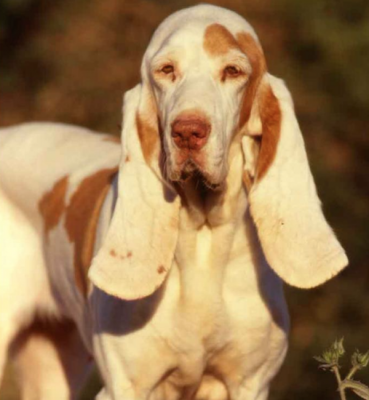
Meet the Sabeusos Espanoles, also known as the Chien Courant Espagnol, or Spanish Hound.
Most of us notice those magnificent ears first, and we wouldn’t be faulted for thinking they belong to a very large dog. In fact, the breed’s FCI standard calls for a male to be no taller than 22,” smaller than a Bloodhound.
The breed is believed to have been originally developed in France, its name given to it by ancient people that inhabited Central France. Certainly it was already known in the Middle Ages, having been mentioned in the venery book, “Libro de la Monteria” by King Alphonse XI of the 14th century. This was a dog that so excelled at boar hunting, it was regarded as a “specialist,” especially at an old and traditional type of hunting called “caza a traílla” in which the dog was put on a leash to lead a hunter. A distinctively loud, booming howl that modulated over the course of a hunt guided the hunter by indicating if the dog was a on cold trail or fresh scent, if s/he found double scent lines, or whether or not the hunter should be ready for the kill.
After the Spanish Civil War years, the breed was on the verge of extinction, particularly as British and German hunting dogs became popular. Had it not been for Antonio Lopez Milan who reconstructed the Spanish Hound to its original appearance and ensured that its hunting ability was retained, it would have vanished.
The dog is still hunted over in Spain, and because it’s a relentless tracker that excels at blood tracking, it’s no surprise that the breed can be found as a SAR (Search and Rescue) dogs, and in law enforcement to sniff out drugs and bombs.
This was one of the first indigenous breeds admitted by the Royal Dog Society in 1911. The Sabuesos isn’t recognized by AKC, but it is recognized by the FCI, and was accepted as the Spanish Hound by the UKC in 1996.
Image found on Pinterest and happily credited upon receipt of information
